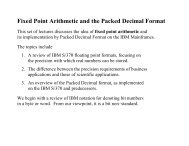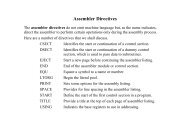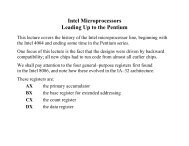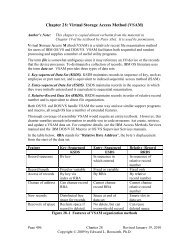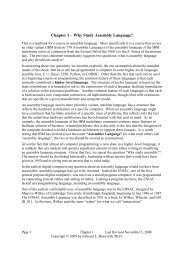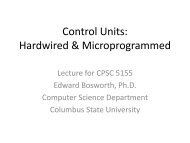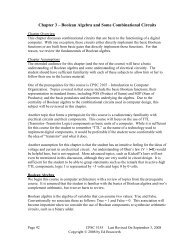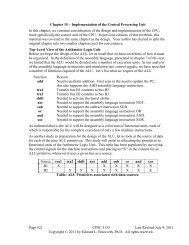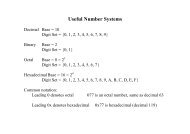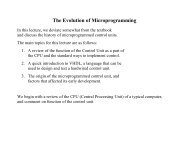PDF Version - Edwardbosworth.com
PDF Version - Edwardbosworth.com
PDF Version - Edwardbosworth.com
You also want an ePaper? Increase the reach of your titles
YUMPU automatically turns print PDFs into web optimized ePapers that Google loves.
S/370 Assembler Language Binary Integer Data<br />
Consider the following example<br />
BAD<br />
DC H‘73728’ IN HEXADECIMAL, X‘12000’<br />
This is truncated to a value of 8,192, which is X‘2000’. The leading 1 is dropped<br />
from the hexadecimal representation, because only the last four digits fit into the<br />
half–word storage allocation; 4 hexadecimal digits = 2 bytes = 1 half–word.<br />
Sequential Memory<br />
Consider the following two declarations which are sequential. Each is a half–word,<br />
which is declared using the hexadecimal construct to make the example clear.<br />
H1 DC XL2‘0102’ DECIMAL 258<br />
H2 DC XL2‘0304’ DECIMAL 772 At address H1+2<br />
The half–word value stored at address H1 is hexadecimal0102 or decimal258.<br />
The full–word value stored at address H1 is hexadecimal01020304, or<br />
16, 909, 060 in decimal. This fact can present problems for the incautious coder.<br />
To load the value of the half–word at address H1 into a register, one uses the Load<br />
Half–word instruction; e.g.,LH R4,H1. Register R4 gets 258. But if I accidentally write a<br />
full–word load instruction, as inL R4,H1, then register R4 will get the decimal value<br />
16, 909, 060. This is due to the fact that the four bytes beginning at address H1 have the<br />
valueX‘0102 0304’. The fact that H1 and H2 are defined separately matters not at all.<br />
Similarly, suppose I declare a full–word as follows.<br />
F1 DC XL4 ‘11121314’ DECIMAL 17,899,828<br />
If the code saysLH R4,F1, then F1 gets hexadecimal X‘1112’ or decimal 4370.<br />
Binary Constants and Hexadecimal Constants<br />
The type B declaration uses binary numbers (0 or 1) to define a string of bits. The type X<br />
declaration uses hexadecimal digits to define what is also just a string of bits.<br />
Consider the following pairs of declarations.<br />
B1 DC B‘10101110’<br />
X1 DC XL1‘AE’ READ AS 1010 1110<br />
B2 DC B‘0001001000010011’<br />
X2 DC XL2‘1213’ READ AS 0001 0010 0001 0011<br />
B1 and X1 each declare the same bit pattern.<br />
B2 and X2 each declare the same bit pattern.<br />
Personally, I find the hexadecimal constants much easier to read, and would suggest not<br />
using the B declaration. The most <strong>com</strong>mon use for the binary declaration would be to set bit<br />
patterns to be sent to registers that control Input/Output devices. In standard programming,<br />
we do not have access to those registers on a System/360 or later mainframe..<br />
Page 222 Chapter 12 Last Revised July 6, 2009<br />
Copyright © 2009 by Edward L. Bosworth, Ph.D.



